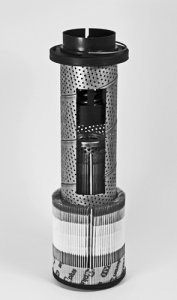Filter elements are rated on their ability to remove contaminants of specific targeted sizes from a fluid under specific operating conditions. Filtration ratings can be measured by analyzing three areas of performance:
1. Dirt holding capacity
2. Absolute rating (micron) and percent efficiency (beta ratio)
3. Pressure drop across the element at a specific absolute efficiency
Filters with increased performance provide the benefits of longer filter change intervals, improved oil cleanliness and higher nominal flow rates. Since 2000, the dirt holding capacity of a filter element with a 10 µm(c) media has been increased by more than 100% with design improvements.
Characteristics of a Good Hydraulic Filter
Filter elements are complex hydraulic components. In addition to the three characteristics above, others play an important role. These are flow-fatigue strength, differential-pressure stability, Beta value (efficiency) stability and wide fluid compatibility. This lead to:
- The efficiency and absolute rating of a filter element. These are essential for the system’s oil cleanliness over the entire service life.
- The flow-fatigue strength of the filter material, which ensures the required oil cleanliness also with changing volume flow.
- Long filter-change intervals come from a high dirt holding capacity, and sufficient flow fatigue strength and material resistance.
- Differential-pressure stability guarantees intact and functioning filter elements especially during cold starts which stress filter materials with a low oil viscosity.
- The differences between original and replica filter elements are detectable only in a laboratory on a suitable test bench and by standardized tests.
Today’s Demands
It’s no surprise that user requirements vary. However, the trend is clearly going to higher oil cleanliness levels and longer filter change intervals as well as to an increased media resistance and compatibility with various hydraulic oils.
Special requirements call for special solutions. For example, filter elements for split power transmissions may require a high flow-fatigue strength, water absorbing elements or electrically conductive filter elements when using oil with low conductivity.
Special Problems: Electrostatic Charges
The conductivity of an oil depends on the base oil and additives. Another trend is toward higher refined base oils (group II and III) because of environmental standards. However, these oils display a lower electrical conductivity because they no longer contain heavy metals, and can generate electrostatic charges under certain operating conditions such as high fluid loading.
A non or low-conductive hydraulic oil in a system generates an electrostatic charge at the interfaces between oil and non-conductive surface, such as between the filter fleece and hoses. The charge is a result of the fast separation of two non-conductive surfaces. Thus the charge cannot be balanced thereby producing a charge separation. A large enough charge will produce discharges in the form of flashes. Because of the large non-conductive surface in the filter elements, the effect may occur and grow with increased oil flow.
Conventional filter material may be damaged due to discharge flashes and their related high temperatures. Discharges also produce holes in the filter media through which dirt particles may pass. This results in an increased wear of the hydraulic components, which can end in malfunction and machine failure.
High-temperatures flashes also lead to a deterioration of the oil characteristics, a reduction to oil life, and premature oil aging. The resulting oil-aging products also shorten the filter element life. Adjacent electric components may also be damaged by electric discharges.
A Solution To Electrostatic Charges
Static charges must be balanced to ensure that the electric discharge of the oil does not exceed certain values. For this, a filter element has been developed to ensure charge balancing and prevents the flashes.
System Solutions
The design trend towards system solution continues. With increasing importance of Supply Chain Management among machine manufacturers, there is a clear trend towards integrated solutions in the supply chain. This includes functional and system integration with particular focus on the reduction of interfaces as well as on the production of pre-assembled and tested functional units.
By Meagan Santos, Hydac USA
Filed Under: Filters, News





